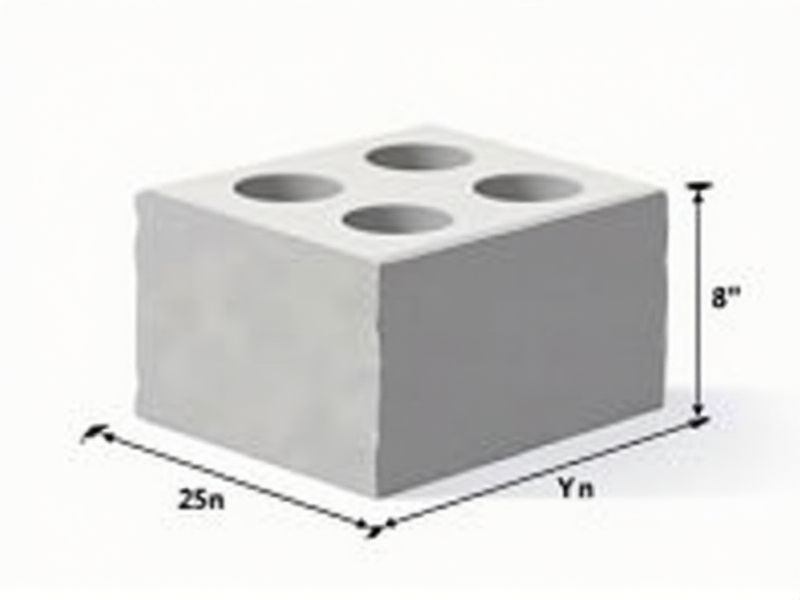
Standard cinder blocks, commonly used in construction, typically measure 8 inches high by 8 inches deep by 16 inches long (8" x 8" x 16"). These dimensions refer to the nominal size, which includes space for mortar between blocks once they're installed. However, actual block sizes are slightly smaller, usually about 7 5/8 " x 7 5/8 " x 15 5/8 ", to account for the mortar joint. Knowing these standard sizes helps ensure accurate material estimates and smooth project planning for both professional builders and DIY enthusiasts.
Dimensions: 16 X 8 X 8 Inches
A standard cinder block measures 16 x 8 x 8 inches, making it a versatile building material extensively used in construction. Weighing approximately 38 pounds, these blocks offer a durable solution for both structural and landscaping projects. The hollow core design allows for easy integration of reinforcement, significantly increasing strength and stability. You can utilize cinder blocks for foundations, walls, or outdoor features like fire pits and benches, highlighting their multifunctional nature.
Industry Standard
Cinder blocks, typically measuring 8 inches by 8 inches by 16 inches, adhere to industry standards that ensure uniformity and structural integrity. Weighing around 28 pounds each, they offer excellent compressive strength, often exceeding 1,900 psi, making them a preferred choice for load-bearing walls. The standard dimensions facilitate easy stacking and create a solid foundation for various construction projects. By utilizing cinder blocks that comply with these industry standards, you can enhance the durability and longevity of your building structures.
Variability By Region
Cinder block standards can vary significantly by region, influenced by factors such as climate, local construction practices, and building codes. In the United States, common dimensions for cinder blocks are 16 inches long, 8 inches high, and 8 inches deep, but this can differ in international markets where dimensions might be metrically standardized. For example, in Europe, cinder blocks may follow the standard of 600 mm by 300 mm by 200 mm, reflecting local building traditions and material availability. Understanding these regional variances is critical for ensuring compliance with construction regulations and maximizing the structural integrity of your projects.
Mortar Joints Consideration
Cinder blocks, commonly measuring 8 inches by 8 inches by 16 inches, should have mortar joints that are 3/8 inch wide to ensure structural integrity. The consistency of the mortar mix, typically a blend of Portland cement, sand, and water, plays a crucial role in achieving optimal adhesion and durability. Regular inspections for cracks or degradation in mortar joints can prevent water infiltration and potential structural failure, ensuring your masonry lasts longer. Properly executed mortar joints contribute significantly to the overall strength and aesthetic appeal of cinder block walls.
Full Vs. Half Blocks
Cinder blocks, commonly used in construction, come in two primary sizes: full blocks measuring 16 inches by 8 inches by 8 inches and half blocks measuring 8 inches by 8 inches by 8 inches. Full blocks provide structural integrity and are ideal for foundational work, while half blocks are often utilized for filling gaps and achieving specific aesthetic designs. The choice between full and half blocks can influence not only the strength of a structure, but also its thermal and sound insulation properties. Knowing these distinctions helps you make informed decisions for your building projects, ensuring optimal performance and durability.
Nominal Vs. Actual Dimensions
Cinder blocks typically have nominal dimensions of 8 x 8 x 16 inches, which includes the mortar joint, while their actual dimensions are approximately 7.5 x 7.5 x 15.625 inches. This discrepancy arises because nominal dimensions provide a simplified method for estimating building needs without accounting for specific tolerances. Understanding this difference is crucial for ensuring proper alignment and fit during construction projects. Accurate measurements can greatly affect the structural integrity of your build, emphasizing the importance of acknowledging both the nominal and actual dimensions in your plans.
Cores For Reinforcement
Cinder blocks, traditionally used in construction, typically feature two to four cores designed specifically for reinforcement. These cores enhance structural integrity by allowing the insertion of steel rebar or grout, which can significantly increase their load-bearing capacity. A standard cinder block measures 16 inches in length, 8 inches in height, and 8 inches in width, making their core configuration critical for various building requirements. When choosing cinder blocks, you should consider the core size and type to ensure optimal strength and compliance with local building codes.
Modular Design Compatibility
Cinder blocks, typically measuring 16 inches long, 8 inches high, and 8 inches wide, are engineered for modular design compatibility, facilitating easy assembly and versatile applications in construction. Their standardized dimensions allow for seamless integration into various building projects, optimizing both structural integrity and aesthetic appeal. Weighing approximately 38 pounds each, cinder blocks are convenient for transport and handling, making them a popular choice among builders. You can enhance your construction efficiency by utilizing these blocks, which not only provide durability but also align with sustainable design practices.
Load-Bearing Capacity
Cinder blocks, also known as concrete masonry units (CMUs), typically exhibit a load-bearing capacity of approximately 1,200 to 3,000 pounds per square foot, depending on their density and design. The maximum compressive strength for standard cinder blocks can range from 1,000 psi to 2,500 psi, making them ideal for structural applications in buildings and walls. When considering your construction project, it's crucial to choose blocks with a higher density for load-bearing walls to ensure adequate support and durability. Always verify the specifications in accordance with local building codes to ensure safety and performance.
Thermal Insulation Properties
Cinder blocks typically have a thermal conductivity of 0.80 to 1.23 W/m*K, which significantly influences their thermal insulation properties. You can expect cinder blocks to provide a thermal resistance (R-value) around 1.0 to 2.0 per inch of thickness, depending on the type. This makes them ideal for energy-efficient construction, allowing for better temperature regulation within residential and commercial buildings. When combined with other insulating materials, cinder blocks can effectively reduce heating and cooling costs by enhancing the building's overall thermal performance.
